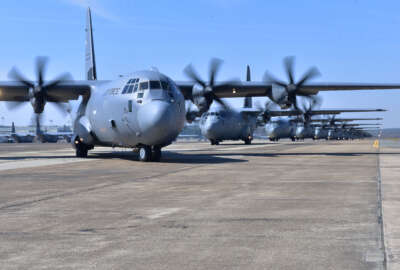
Air Force thinking of new ways to divest from old systems in 2023
Congress is unlikely to bite on $1.4 billion in divestments the Air Force proposed for the 2022 budget.
After another partially failed attempt to divest from legacy aircraft, the Air Force is rethinking how it can convince Congress to retire some of its aging weapons.
Air Force Chief of Staff Gen. C.Q. Brown said the service is discussing everything from getting rid of old weapons to canceling programs to Base Realignment and Closure as a means of reprioritizing funds for the 2023 budget for future weapons systems.
“I’ve got to be able to transition from today to tomorrow and balance some of that risk,” Brown said Wednesday at the Defense News Conference.
He said one tactic he is using is to prepare lawmakers, industry and other stakeholders for the changes the service wants to make.
“I purposely spent a lot of time engaging with them to lay out where the future of the Air Force needs to go,” Brown said. “It’s hard to just do a table drop and that’s the first time anybody sees the plan. It’s multiple conversations over time to lay out where we need to go as an Air Force. There’s several different options that we lay out depending on the decision that gets played out that impacts some other decisions. That’s the thing that I’m working through internally with the staff.”
One of the options Brown and Air Force Secretary Frank Kendall are considering is bundling some of the divestments together, as in retiring full fleets of weapons instead of just phasing out a few planes at a time.
“Each individual decision is bundled and what we tend to do is we’ll gravitate to the individual decision and forget about the rest of the bundle, and we’ll fight and we’ll debate and discuss each one of these individual decisions,” Brown said. “I’ve tried to flip the script a little bit here and really talk about where the Air Force needs to go.”
Bundling would get all the necessary lawmakers to agree on what systems could be cut so the Air Force wouldn’t have to have those individual fights with each district and state.
Brown said he wants to show lawmakers what happens if decisions don’t go forward and how they have a ripple effect within the Air Force.
In the 2022 budget the Air Force proposed a savings of $1.4 billion by getting rid of some of its A-10s, F-15s, F-16s, KC-135s, KC-10s, C-130Hs, E-8s and RQ-4s, a total of more than 200 aircraft.
Brown tried to alleviate lawmakers’ fears in June by assuring them that planes leaving their districts would be replaced by upgraded units.
The Senate Armed Services Committee already nixed the idea of retiring A-10s.
Paul Arcangeli, staff director for the House Armed Services Committee, explained why it’s so hard for lawmakers to let go.
“Just because retiring a system is logical, doesn’t mean it’s going to be accepted by Congress,” he said. “It kills my soul to say it, but the facts are interesting and often unimportant when you’re dealing with these kinds of things. We live in the world of politics; the members are looking at it in a different way. We try and explain it to the members, we try and tell them to do the system retirement, we try to show them the national security benefit, but in the end they have to support their district.”
Copyright © 2025 Federal News Network. All rights reserved. This website is not intended for users located within the European Economic Area.
Scott Maucione is a defense reporter for Federal News Network and reports on human capital, workforce and the Defense Department at-large.
Follow @smaucioneWFED





